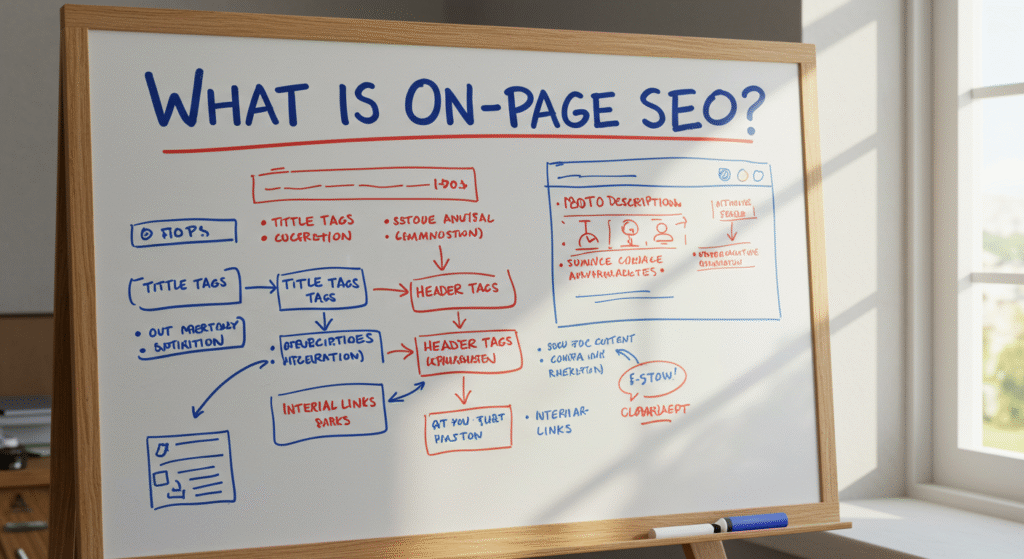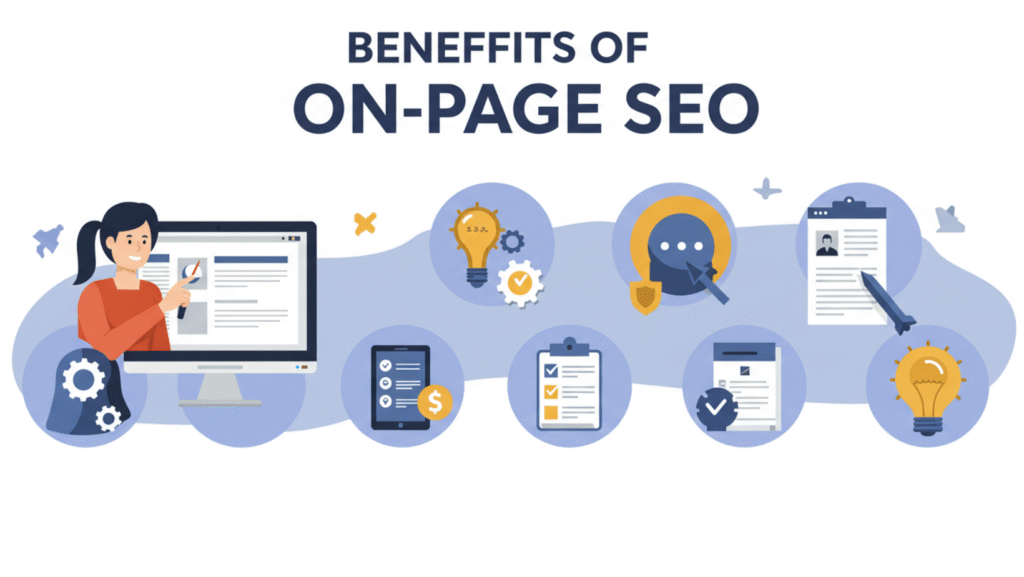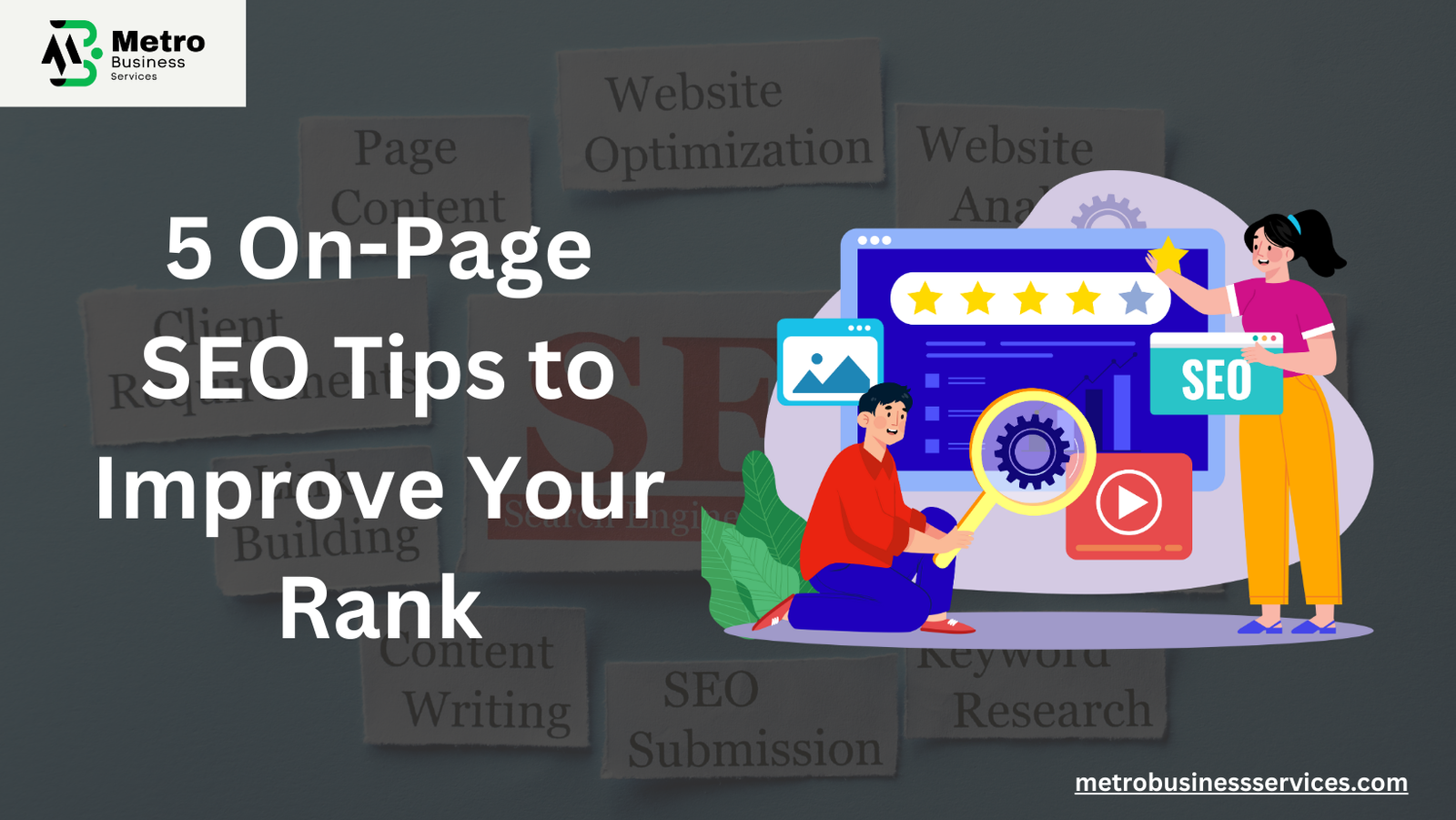In the constantly evolving world of digital marketing, understanding and implementing on-page SEO is essential for achieving higher rankings in search engine results. This guide, titled ‘5 On-Page SEO Tips to Improve Your Rank,’ highlights the most important SEO factors and provides a comprehensive approach to mastering content optimization and search visibility. From mastering the elements of SEO to optimizing individual components of search engine optimization, businesses and marketers must adopt a strategic approach to content and site structure. This article outlines the most important SEO factors, explores essential SEO tactics, and provides a clear breakdown of on-site SEO elements that influence search results. Whether you’re looking to improve internal site search optimization or simply understand what is SEO and why it is important, these tips will help boost your visibility and engagement across search platforms.
What Is On-Page SEO?
On-page SEO refers to all the actions taken within your website to improve its position in search rankings. It involves optimizing various elements of search engine optimization such as content, HTML source code, and site architecture. Key aspects of SEO include title tags, meta descriptions, header tags, and internal linking. Understanding what is on-page SEO and why it is important is essential for boosting your online visibility.

These features of SEO ensure that your website is aligned with search engine algorithms and user expectations. By addressing the most important SEO factors and integrating essential SEO components, you create a strong foundation for long-term digital success.
Optimize Title Tags and Meta Descriptions
Your title tag is the first impression search engines and users have of your page. A well-crafted title tag should include the primary keyword and reflect the content’s purpose. Meta descriptions, though not a ranking factor directly, influence click-through rates. Make sure they are unique, compelling, and include relevant terms related to your page. These elements of search engine optimization are essential SEO practices that support visibility and attract user engagement, highlighting the importance of on-page SEO in delivering high-quality, search engine optimized content.
Key Points:
- Ensure every page has a unique title tag.
- Keep titles between 50-60 characters.
- Meta descriptions should be around 155 characters.
- Use essential SEO components like the target keyword near the beginning.
Structure Your Headings Strategically
Heading tags (H1, H2, H3…) help break content into digestible sections and signal content hierarchy. The H1 tag should only appear once per page and must include the main topic. Subsequent headings support skimmability and help search engine crawlers understand the structure.
Best Practices:
- Use a single H1 per page.
- Utilize H2s and H3s to organize subtopics.
- Incorporate on-page SEO elements naturally within headers.
- Reflect elements of search engine optimization in subheadings.
Enhance Content With Semantically Related Keywords
Semantic SEO involves using contextually relevant phrases and variations of your keywords. It helps search engines grasp your topic better and rank your content for a wider array of search queries. This method enhances the overall structure of on-page SEO elements, improves your site’s relevance to user queries, and ensures you’re aligning with the most important SEO factors. Integrating components of search engine optimization such as keyword clusters, related terms, and natural language variations also contributes to increased visibility and authority within search engine results.
Semantic Strategies:
- Avoid keyword stuffing; use LSI (Latent Semantic Indexing) keywords.
- Focus on aspects of SEO related to your primary keyword.
- Include examples of SEO practices.
- Address questions like “why is search engine optimization important” within your content.
Improve Internal Linking and Site Navigation
On-site SEO elements that influence search results include how users and crawlers navigate your website. Internal links help distribute page authority and guide users to relevant content. These essential SEO practices are considered key components of search engine optimization and play a vital role in boosting page authority. Proper internal linking is a part of the most important SEO factors, aiding search engines in better understanding the structure of your website while also improving the user experience.
Linking Techniques:
- Use descriptive anchor text.
- Link to essential SEO articles and resources.
- Highlight related components of search engine optimization.
- Optimize UX and internal site search optimization.
Optimize Page Speed and Mobile-Friendliness
Search engines prioritize user experience. Fast-loading, mobile-responsive websites perform better in search rankings. These technical SEO aspects intersect with on-page optimization and are critical components of SEO that influence visibility. Incorporating elements of search engine optimization such as performance speed, responsive design, and optimized page structure ensures your site aligns with important SEO factors. These features of SEO also enhance usability and reduce bounce rates, contributing to better overall search engine performance.
Performance Enhancements:
- Compress images and enable lazy loading.
- Use a responsive design.
- Minify CSS, JavaScript, and HTML.
- Evaluate using tools like Google PageSpeed Insights.
Benefits of On-Page SEO
Implementing on-page SEO offers several advantages that contribute to long-term digital success. It enhances your website’s visibility in search engine results by optimizing elements of search engine optimization like title tags, headers, and internal linking. On-page SEO also improves user experience by ensuring fast loading times, mobile responsiveness, and relevant content—all of which are important SEO factors.

These essential SEO tactics help build trust, boost engagement, and increase your chances of ranking higher in SERPs. By focusing on the features of SEO and key components of search engine optimization, you can drive more organic traffic and reduce reliance on paid ads.
Key Benefits:
- Increases visibility through optimized elements of search engine optimization.
- Enhances user experience with fast load speeds and responsive design.
- Strengthens internal site search optimization for easier navigation.
- Builds credibility and trust with well-structured, informative content.
- Aligns your site with the most important SEO factors and algorithm requirements.
Why Is On-Page SEO Important?
5 On-Page SEO Tips to Improve Your Rank can significantly enhance the visibility and relevance of your web content. On-page SEO aligns your site with the algorithmic requirements of search engines and addresses human factors in search engine optimization, such as readability and engagement. Whether you’re practicing SEO as a freelancer or running an agency like Metro Business Services, mastering these factors is critical.
Buy Now – Expert On-Page SEO Services
Looking to optimize your website professionally? Metro Business Services offers expert on-page SEO services tailored for businesses aiming to improve visibility and search rankings.
Frequently Asked Questions
What are the 5 important concepts of SEO?
The five concepts are on-page SEO, off-page SEO, technical SEO, content relevance, and user experience optimization.
What are the five most important on page optimization factors?
Title tags, content quality, internal linking, header usage, and meta descriptions are crucial components of search engine optimization and represent essential SEO strategies for achieving higher visibility and better user engagement.
What are the important elements of on-page SEO?
Important elements include keyword placement, structured data, mobile responsiveness, and semantic keyword usage.
Which of the following are important on-page SEO elements?
Headers (H1-H3), internal links, image alt tags, title tags, and structured content.
Why is on-page SEO important for website ranking?
It directly affects how search engines understand and rank your content.
How do semantic keywords improve on-page SEO?
They expand keyword reach and help search engines understand the context.
What is the difference between on-page and off-page SEO?
On-page SEO refers to optimizations made directly on the site, while off-page relates to backlinks and external signals.
What makes content SEO-friendly?
SEO-friendly content is well-structured, keyword-optimized, and addresses user intent effectively.
Conclusion
5 On-Page SEO Tips to Improve Your Rank go beyond simply inserting keywords; it’s about structuring your content, enhancing user experience, and optimizing every visible and invisible aspect of your page. By applying semantic SEO and considering the essential elements of search engine optimization, you set your site up for improved rankings and increased visibility. Incorporating aspects of SEO like the SEO periodic table, internal site search optimization, and human factors in search engine optimization helps deliver long-term results and aligns your content with the most important SEO factors in today’s digital landscape.
Metro Business Services is ready to help you implement these strategies and reach the top of search engine results.

